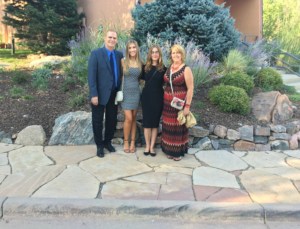The MOG Project at SRNA
By Kristina Lefelar
In the Fall of 2013, my first year of college was finally beginning. I was loving life, embarking on new experiences, and finding my passions. I had always been a homebody growing up and my mom was my best friend – we always stayed connected. Things were going very well and I wasn’t worried about much going wrong at the time. One day in the Spring of 2014, I received a call from my parents. My dad told me that my mom had extreme pain in her eyes and was going blind.
My family was in a state of confusion and fear. As I continued my semester, my family kept me updated on the status of her vision. My parents were going to doctors trying to get to the bottom of it. When we met for lunch, we had to help escort her around because her vision was “blocked” by a large dark spot. When I moved out of my dorm room in May, she perceived the evening daylight as darkness, thinking it was nighttime. I never would have guessed that this was what I would be coming home to for summer break.
She was finally given a diagnosis – NMOSD (Neuromyelitis Optica Spectrum Disorder). NMOSD is a demyelinating disease that attacks the optic nerve and spinal cord. My mom was put on Rituxan and stayed on this treatment for four years. She was referred to Dr. Michael Levy for care, who is a world authority on NMOSD and heads research on this subject. He decided to treat her with Rituxan, but she had breakthrough attacks about once a year. Some attacks continued to further damage her eyesight, and some caused weakness, spasms in her legs, and loss of bladder control.
Recently, Dr. Levy finished developing an antibody test at Johns Hopkins for MOG. MOG antibody disease presents itself similarly to NMOSD. The difference is the mechanism of the disease; NMOSD targets Aquaporin-4, while MOG antibody disease targets myelin oligodendrocyte glycoprotein (MOG). My mom tested negative for the MOG test in the past, but with Dr. Levy’s new, more sensitive test, she tested positive. She had finally found her smoking gun. This new diagnosis was significant for the path of her treatment plan. Since Rituxan had not been working as well as expected, her medicine was then switched to CellCept.
Watching these series of events unfold has inspired us to take action on the lack of awareness for this rare auto-immune disease. The MOG Project is a campaign that we have launched under the umbrella of SRNA that advocates for a spectrum of rare neuroimmune disorders. The Project will stand up for MOG patients and help us obtain a better understanding of this illness. There are not adequate online resources for us to seek help and support, besides the MOG Facebook group. During the “non-attack” periods, many MOG patients do not look ill. My mom remained positive and continued to be the super-mom that she is – it is easy to forget what someone is going through when they have an “invisible” illness. This is why we need to provide an outlet for MOG patients – to show them that they are not alone in this fight.
Our story is important. Myself, Julia Lefelar, Cynthia Albright, Amy Ednie, Peter Fontanez, and Pamela Fontanez are teaming up with SRNA to tackle the missing pieces for the MOG community. As the founders of the MOG Project, we hope to provide MOG patients with everything that my mom did not have. We strive to influence the medical community to maintain a better understanding of this rare auto-immune disease, so that they can be prepared for future diagnoses. We hope to push for research funding that will aid in finding a cure through fundraising and donation efforts. We believe that it is our duty to educate new MOG patients on their disease, connect them with a supportive community, and raise awareness to our mission.
For more information on MOG Antibody Disease, please view the information sheet or listen to our Ask the Expert Podcast on this disease here.






